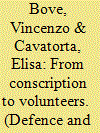| Srl | Item |
| 1 |
ID:
153087


|
|
|
|
|
| Summary/Abstract |
Strategic interactions between countries, such as arms races, alliances and wider economic and political shocks, can induce strong cross-sectional dependence in panel data models of military expenditure. If the assumption of cross-sectional independence fails, standard panel estimators such as fixed or random effects can lead to misleading inference. This paper shows how to improve estimation of dynamic, heterogenous, panel models of the demand for military expenditure allowing for cross-sectional dependence in errors using two approaches: Principal Components and Common Correlated Effect estimators. Our results show that it is crucial to allow for cross-sectional dependence, that the bulk of the effect is regional and there are large gains in fit by allowing for both dynamics and between country heterogeneity in models of the demand for military expenditures.
|
|
|
|
|
|
|
|
|
|
|
|
|
|
|
|
| 2 |
ID:
112391


|
|
|
|
|
| Publication |
2012.
|
| Summary/Abstract |
A growing number of NATO countries suspended compulsory military service during the past decade or are now phasing it out, moving to an All Volunteer Force (AVF). An AVF can free resources available for investment in up-to-date equipments, thus improving operational capabilities. Our paper investigates shifts in NATO military expenditure shares on personnel, equipment, infrastructure and other costs over the period 1970-2008 and explores the impact of the transition to AVFs on these shares of the defence budget. Results suggest that while the end of conscription did not reduce the share of spending on personnel, NATO forces are increasingly less reliant on soldiers and more on capital.
|
|
|
|
|
|
|
|
|
|
|
|
|
|
|
|
| 3 |
ID:
098337


|
|
|
|
|
| Publication |
2010.
|
| Summary/Abstract |
In this paper we explore the patterns of interactions between military expenditure shares in the MENA region over the period 1979-2007. We explore whether there are latent common factors that impact on the military expenditures of 15 countries in the MENA region and whether these factors can be interpreted. Unobserved common factors induce cross-sectional dependence and may lead to traditional panel-time series estimators being inconsistent. To identify these latent factors we apply principal component analysis. We evaluate the interpretation of the estimated factors using the multiple-indicator multiple-cause model. We find that there is a substantial evidence of cross-sectional dependence in the MENA region, induced mainly by two unobserved factors, but these factors are difficult to interpret.
|
|
|
|
|
|
|
|
|
|
|
|
|
|
|
|